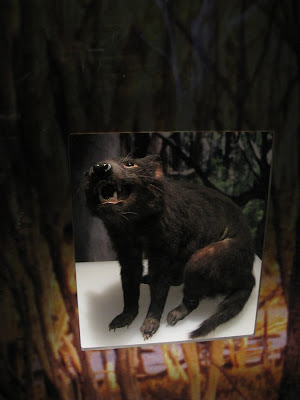When I saw the posters outside of the Australia Museum for the exhibit "Surviving Australia," I thought maybe it was an exhibit about how humans survived all of the deadly creatures on this isolated continent, once known in Europe as "terra australis incognita" (unknown southern land). This was only part of the story.
Upon entering the exhibit I realized it was more about how the creatures survived the deadly invading humans. Extinct, endangered, and threatened animals were featured in varying media. Threatened and endangered animals had taxidermied representatives. The extinct were mainly shown in illustrations, with the eerie exception of the Tasmanian tiger, of which there was archival film footage.
Thylacine, or Tasmanian tiger, was exterminated by man by the early 20th century. It had the appearance of a canine, but like many Australian animals, it was marsupial. [Read more here.]
There were life-sized recreations of megafauna, long extinct when Westerners arrived. Giant wombat-like marsupials and enormous kangaroos (up to 10 feet tall) once roamed the continent.
Thylacoleo, an extinct marsupial lion.
The fate of several animals was doomed upon the arrival of the white man. According to the exhibit, "in the last 200 years, over 50 vertebrate species and an unknown number of invertebrates and plants have disappeared from Australia -- presumed extinct." With habit destruction, introduction of foreign plant and animal species, and sometimes intentional extermination, the pig-footed bandicoot, several types of emu, kangaroo, and wallaby, and the Tasmanian tiger met their untimely end. Today, countless birds, amphibians, reptiles, and mammals are endangered or threatened because of humans. And Australia is sparsely populated compared with other continents (barring Antarctica), with about 21 million people covering the whole country.
The endangered regent honeyeater.
The endangered Tasmanian devil (I have a photo of a live one in my broken memory card).
When land is cleared did you know that everything living is killed? Between 1972 and 2006 it has been estimated nearly 4 billion birds, mammals and reptiles have died as a result of land clearing in Australia.
One-third of Australia's woodlands... has been destroyed.
An estimated 50 percent of wetlands have been destroyed.
Over three-quarters of Australia's rainforests have been destroyed.
Alright, let's get down to the fun stuff -- the animals that are deadly to humans! I timed my trip to the museum perfectly, because the next day we were off to the tropical north, where all of these toxic creatures live. Saltwater crocs, chironex and irukandji box jelly fish, death adders -- they're all in Queensland's coastal regions. And let's not forget the great white shark!
Huge, predatory Saltwater Crocodiles are one of Australia's most famous dangers. They're the world's biggest living crocodiles and can swim underwater at 30 kilometres per hour [18.6 mph] without causing a ripple. They can leap out of water fast enough to outrun a horse (over a short distance) and far enough to catch low-flying birds.
It was kind of an exciting prospect to be able to possibly witness one of these creepy beings. I avoided going in the water for fear of deadly jelly stings. (I went for a horseback ride and even Rocky, my trusty steed, wouldn't take a dip -- maybe he knows something I don't!) Every branch brushing against my legs was a Sydney funnel-web spider waiting to intoxicate me.

An interactive display describes the chironex box jellyfish
Alas, the scariest thing I came across was a little baby reef shark on the Great Barrier Reef -- and he was so scared of me that he darted away as soon as a I spotted him. But my boyfriend got to see a young saltwater crocodile on Bedarra Island -- I wonder where mama croc was?!




























































